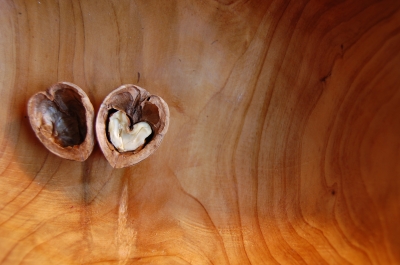Preserve potassium when preparing potatoes
If you’re making mashed potatoes or many other potato dishes, what do you do? Cube the potatoes and throw them in a pot of water to boil? If you want to hang on to the potassium potatoes offer, it’s best to boil the potato whole – skin and all. When potatoes are cubed or shredded then boiled, studies show a 75% loss of potassium.
Also, good news if you like to soak your potatoes in water overnight. Soaking potatoes does not result in a significant loss of nutrients to the water they’re soaked in.
For regular heart health and weight loss tips from dietitian Lisa Nelson, be sure to sign up for The Heart of Health ezine.
Omega 3’s and Walnuts

Sometimes people wonder about the health benefits of the black walnut versus the more common English walnut, so I’m going to provide you some quick info.
The English walnut contains more omega 3 fatty acids per ounce than the black walnut (2.6 grams versus .57 grams). To promote heart health, increasing your omega 3 fatty intake is a good step to take, so opt for the English walnut (which is easier to find anyway).
Another component to keep in mind:
The type of omega 3 fatty acid contained in walnuts is ALA (alpha linolenic acid). The conversion of ALA to EPA and DHA (the two types of omega 3 fatty acids linked to health benefits) is inefficient.
The Heart of Health
Be sure to sign up for The Heart of Health to receive regular heart health and weight loss tips from dietitian Lisa Nelson!
Image courtesy of Aleksa D / FreeDigitalPhotos.net
Wear a pedometer for heart health and weight loss!
Wearing a pedometer is a simple way to track your activity.
First, wear a pedometer everyday for a week and write your daily steps on a calendar. By the weeks end, you’ll have a idea of how much you move each day.
Next, find ways to increase your steps, such as an extra walk, taking the stairs versus the elevator, parking further from the store, etc.
Make your final goal 10,000 steps (~5 miles) each day!
Lisa Nelson, RD, LN
The Heart of Health
Brown rice – New whole grain health claim.
I’ve always recommended clients make a switch from white rice to brown rice as a way to boost dietary fiber intake. A diet high in dietary fiber (ideally 25-35 grams/day) is linked with reduced heart disease risk by lowering LDL and total cholesterol levels.
The FDA just approved a new ruling that will allow brown rice to use a health claim on its label. So, when you’re shopping for groceries, be on the look out for the new whole-grain logo added to the brown rice packaging and don’t forget to reach for the brown rice over the white! A 1/2 cup of cooked brown rice contains two grams of fiber.
Brown rice takes extra time to prepare (~45 minutes). I checked out the nutrition label on brown “minute” rice recently and it’s another option, still providing 2 grams of dietary fiber per 1/2 cup serving. Best of all, only takes ~10 minutes to prepare. Haven’t tried it yet, so can’t vouch for its flavor, but I have added it to my shopping list.
All the best,
Lisa Nelson, RD, LN
The Heart of Health
Control High Blood Pressure – Switch from canned veggies to frozen.
Canned vegetables are high in sodium, while frozen vegetables (without added sauces) usually have no added sodium. Buy the large economy size bags, pour out the amount you need for your meal, close the bag with zip closure or twist tie and stick back in the freezer until next time!
Making this change will significantly reduce your sodium intake, promote blood pressure control and heart health!
Be sure to sign up for regular heart health and weight loss tips through The Heart of Health ezine!
Eating Breakfast Equals Weight Loss
Do you eat breakfast?
Well, a recent study backs up the claim that breakfast is the most important meal of the day. Two groups of women were compared. The first group followed a low calorie diet (~1200 calories) that included a balanced protein/carbohydrate intake. This first group ate 50% of their daily calories in the morning (~600 calories). The second group followed a low calorie (~1000 calories), low carbohydrate diet and ate ~25% of their calories in the morning. The first group lost ~40 pounds over 6 months, while the second group lost ~10 pounds (28 pounds first 4 months, followed by 18 pound regain).
Balancing protein and carbohydrates in your breakfast is important. Here are some examples of quick and easy breakfast meals that include both protein and carbohydrates.
Whole wheat toast with peanut butter
Low fat cottage cheese with canned peaches (light syrup)
Banana with handful of mixed nuts
Whole grain cereal with low fat milk
Apple with hard-boiled egg
Low fat yogurt with granola
What are you going to eat for breakfast?
All the best,
Lisa Nelson, RD, LN
Heart Health and Weight Loss Tips



